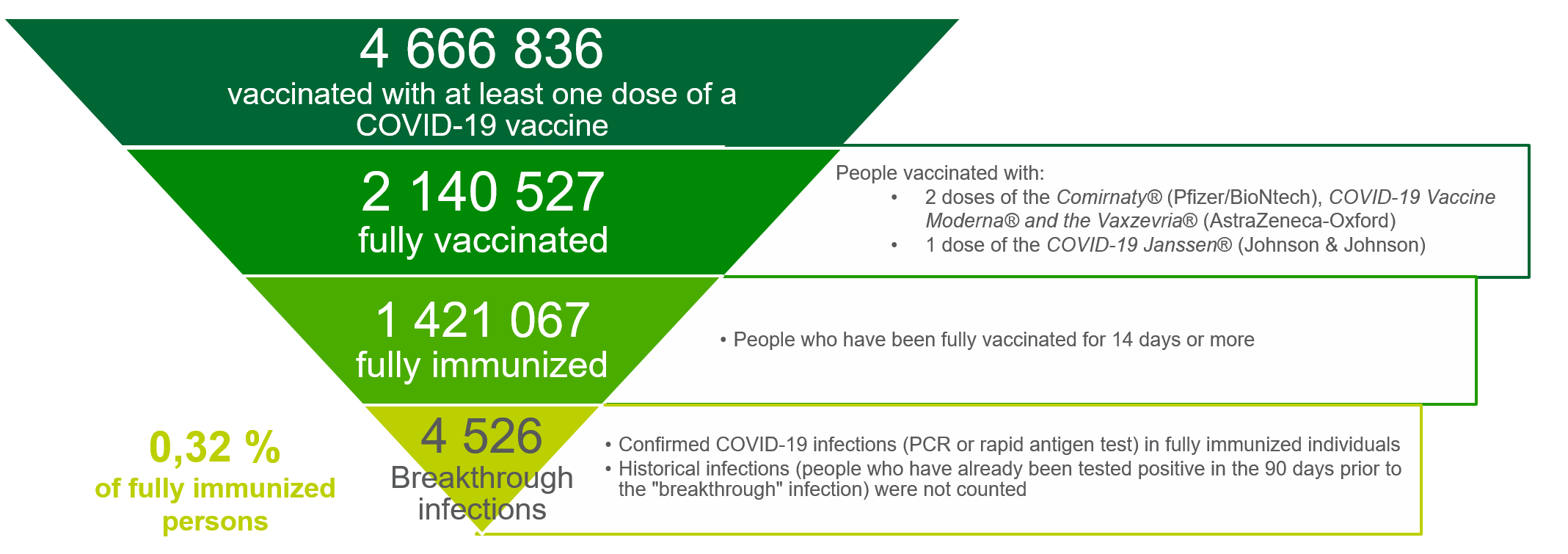Since the start of the COVID-19 vaccination campaign, Sciensano has been closely monitoring the occurrence of infections in fully immunized individuals, also called “breakthrough infections”. On a total of 1.421.067 fully immunized individuals, only 0,32% (4.526) got infected. Moreover, more than two thirds of these breakthrough infections did not cause any COVID-19 compatible symptoms. These results are an important indication of the effectiveness of the COVID-19 vaccines in Belgium.
COVID-19 vaccines have proven exceptionally high efficacy, but no vaccine can offer 100% protection. Monitoring and describing the infections that occur in fully immunized persons, the so-called breakthrough infections, provide precious information on the effectiveness of vaccines.
By the 31st May, over 2 million Belgian residents had received a full vaccination course, among which 1.421.067 could be considered fully immunized (Figure 1). By linking the vaccine registry Vaccinnet+ and the database of COVID-19 test results, scientists from Sciensano could identify 4.526 breakthrough infections. This means that only 0,32% of fully immunized persons got tested positive for COVID-19. In addition, in the last two weeks of May 2021, for example, they detected only 652 breakthrough cases among a total of 27.979 new COVID-19 infections. Breakthrough cases thus represented only 2,33% of all infections recorded during this period. This clearly shows that fully immunized individuals are much less likely to get a COVID-19 infection.
Information on symptoms was available for a substantial portion (74%) of the breakthrough infections, revealing that 68,1% had no COVID-19 compatible symptoms at the time when they were contacted for contact tracing. In other words, the majority of breakthrough infections detected were incidental findings, discovered when testing for other reasons than disease (travel, high risk contact, screening). If breakthrough infections are rare, the risk of symptomatic disease after vaccination is even smaller.

Figure 1. Detection of breakthrough infections after COVID-19 vaccination (31th of May 2021)
Sciensano will continue to closely monitor breakthrough infections
Since the 5th May 2021, laboratories are automatically alerted when a positive COVID-19 sample is a possible breakthrough infection. Such samples can therefore be sent to the Belgian reference lab for COVID-19 (UZ Leuven) for identification of the viral variant involved. So far, information is only available for 356 breakthrough infections, among which we find a predominance of the alpha-variant (UK variant; B.1.1.7; 86,1%) followed by the bèta-variant (Brazilian variant; P.1; 6,2%) and the gamma-variant (South-African variant; B.1.351; 3,6%). These results mirror the general distribution of variants in our country.
Sciensano will continue to closely monitor breakthrough infections. Further analyses are ongoing to identify risk factors of such infections:
- Do they occur more frequently in certain groups of the population?
- Do they vary according to type of vaccine received or the viral variant?
- Among the symptomatic cases, what is the severity of disease and does it differ from COVID-19 infections in unvaccinated persons?
Finally, Sciensano will also investigate whether breakthrough cases increase in time and at what rhythm, giving valuable information on the duration of protection offered by the different COVID-19 vaccines.


